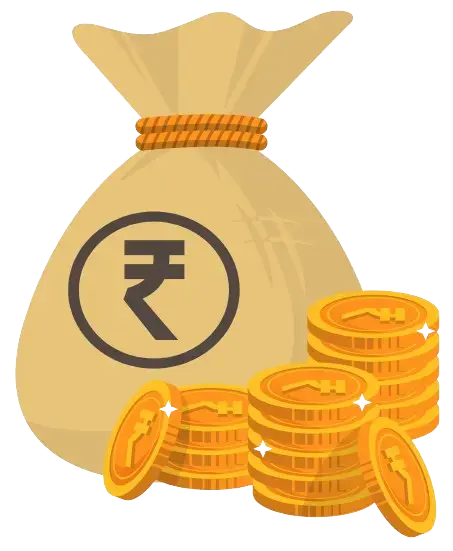Investing in Silver is a great option if you are looking to diversify your portfolio. Silver is an affordable investment option that any new or experienced investor can take advantage of in the form of coins, bars, jewellery, futures or ETFs. Being a precious metal and an industrial commodity, the demand for Silver will offer investors the potential for significant returns. Moreover, unlike paper currencies, silver holds intrinsic value, thereby acting as a hedge against inflation and economic instability.
Additionally, Silver is a great alternative compared to gold due to its liquidity, and potential to perform well during economic downturns. Furthermore, it's easy for common people to invest in silver through online platforms, or even local jewellery stores, making it a practical option for many.
Investing in silver is a smart and accessible way to earn good returns. With the price now at ₹84.50 per 1 gram, anyone can easily invest as it is affordable, a great hedge against inflation, and helps diversify your portfolio.
Table of Contents:
Understanding Silver as an Investment
Silver is a precious metal that has been valued for its appearance and utility for a long time. Known for its versatility, silver is used to make jewellery, coins, and various industrial components in electronics, solar panels and even medical devices. As it has unique properties of high thermal and electrical conductivity, it has become an important material in various industries.
Do you need an instant loan?
Reasons to Invest in Silver
Investing in silver brings about many advantages, making it a compelling addition to your investment portfolio. Given below are some of the reasons why investing in silver can be a good option for you:
- Affordability: Silver is an affordable alternative of investing as compared to gold, thereby, making it an accessible investment option for individuals with smaller budgets. This lower entry point gives more people the opportunity to invest in precious metals without needing substantial capital.
- Industrial Demand: Silver is widely used in various industrial applications, including electronics, solar panels, medical devices, and water purification. This industrial demand supports the value of silver and provides a unique investment opportunity, as its price can rise with increased industrial usage.
- Diversification: Adding silver to an investment portfolio helps diversify holdings, which can reduce overall risk. Precious metals often move independently of stocks and bonds, providing a hedge against market volatility and economic downturns.
- Hedge Against Inflation: Silver, like other precious metals, tends to maintain its value over time and can act as a hedge against inflation.
- Liquidity: Silver is a highly liquid asset, meaning it can be easily bought and sold in the market. This liquidity ensures that investors can quickly convert their silver holdings into cash when needed.
- Historical Value: Silver has been used as a store of value and a medium of exchange for thousands of years. Its long history as a trusted asset provides confidence in its enduring worth and stability.
- Growth Potential: With silver being used in various industries, the demand for silver has significant growth potential. Innovations in renewable energy, particularly solar power, are expected to drive future demand for silver.
- Limited Supply: Silver is a finite resource with limited supply. As mining becomes more challenging and costly, the scarcity of silver can drive up its price, benefiting investors who hold the metal.
- Security: During economic crises or geopolitical tensions, silver often performs well as investors seek safe-haven assets. Holding silver can provide protection against financial instability and market turbulence.
Ways to Invest In Silver In India
Investing in silver can be done through various ways, with each having its own set of benefits and risks. Whether you choose physical silver, digital silver, or paper silver, it is important to consider your financial goals, risk tolerance, and market conditions before making an investment decision. Here's a detailed look at the different ways to invest in silver:
Physical Silver
1. Bullion:
- Silver Bars: Silver bullion refers to buying silver in bulk, such as silver bars. These bars are typically around 99.5% pure, known as parted bullion. They are traded in the commodities market and come without impurities. Silver bullion bars are generally less expensive compared to coins due to lower manufacturing costs.
- Silver Coins: Silver coins are a popular investment option for many due to their ease of purchase and storage. They are more expensive than bars due to additional costs for minting and imprinting. Silver coins can be bought from banks and reputable jewellers and offer the advantage of being easily liquidated when needed.
2. Silver Jewellery: Investing in silver jewellery is common as it is affordable. However, the value of silver in jewellery form may be less due to craftsmanship costs. Whether silver jewellery is a good investment depends on the price paid and the potential for value loss during conversion from bullion to jewellery.
Paper Silver
- Digital Silver on National Spot Exchange (NSEL): Digital silver, or e-silver, is an innovative way to invest in silver. Offered by the National Spot Exchange, it allows investors to buy silver in smaller amounts and hold it in Demat form. To invest, one needs to open a depositary account with NSEL. Investors can also opt to convert digital investments into physical silver.
- Commodity Futures: Investing in silver through commodity futures involves trading contracts on exchanges like MCX and NCDEX. This method relies heavily on market movements and requires a portion of the contract value to be paid upfront. While it can yield high profits, it also carries significant risk due to price volatility.
- Milestone Bullion Series 1: Launched by Milestone Capital, this portfolio investment is similar to mutual funds. It allows investors to invest in a mix of silver, gold deposit schemes, and gold-linked structures. The minimum investment is ₹5 lakhs, with a one-time fee and an annual fund management fee. This investment option is designed for high net worth individuals looking for a diversified portfolio.
Other Investment Methods
- Silver ETFs: Exchange-traded funds (ETFs) that track the price of silver provide a convenient way to invest without holding physical metal. They offer liquidity and can be traded on stock exchanges, making them accessible and easy to manage.
- Silver Mutual Funds: Some mutual funds invest in companies involved in silver mining, offering indirect exposure to silver prices. This method provides diversification and professional management, which can be beneficial for investors looking for a hands-off approach.
Not sure of your credit score? Check it out for free now!
Price of Silver in India
The silver price in India today is ₹84.50 for 1 gram. Given below are the various prices of India as on 26th July 2024, along with its rate in different cities:
Price of Silver per gram/kilogram in India as on 26th July 2024.
| Weight | Price of Silver |
|---|---|
| 1g | ₹84.50 |
| 8g | ₹676 |
| 10g | ₹845 |
| 100g | ₹8,450 |
| 1000g | ₹84,500 |
Read More
Read Less
Price of Silver in Major Cities as on 26th July 2024:
| City | Price per 10g |
|---|---|
| Chennai | ₹890 |
| Mumbai | ₹845 |
| Delhi | ₹845 |
| Kolkata | ₹845 |
| Bangalore | ₹845.50 |
| Hyderabad | ₹890 |
| Kerala | ₹890 |
| Pune | ₹845 |
Read More
Read Less
Do you need an instant loan?
Risks of Investing in Silver
Investing in silver, while potentially rewarding, comes with several risks that investors should consider, these are:
- Price Volatility: Silver prices can be highly influenced by various factors such as industrial demand, geopolitical events, and market speculation. This volatility can result in substantial gains or losses.
- Economic Factors: Silver's price is affected by economic conditions. During economic downturns, industrial demand for silver may decrease, leading to lower prices and vice versa.
- Storage and Security: Physical silver requires secure storage, which can be costly and pose security risks.
- Liquidity Issues: While silver is generally liquid, selling physical silver may not be as quick or simple as selling other investments like stocks or bonds. The process of finding buyers and converting silver into cash can take time and may involve additional costs.
- Market Risk: Investments in silver ETFs, futures, and silver mutual funds are subject to market risks and may not always track the correct price of silver. Furthermore, market conditions, fund management practices, and other factors can impact the performance of these investments.
Do you need an emergency loan?
Beside silver, you can aslo consider investing in commodities. Check more from the links below:
Besides silver, you can also invest in gold, check more from the links below:
Read More
Read Less
Frequently Asked Questions
Investing in silver offers affordability, industrial demand, diversification, inflation hedge, liquidity, and historical value, enhancing portfolio stability and growth.
Silver is more affordable, volatile, with higher industrial demand, while gold is more expensive, more stable, and a stronger hedge.
The different ways to invest in silver are silver bars, coins, jewelries, digital silver on NSEL, commodity futures, silver ETFs and silver mutual funds.
Yes, silver is often a good investment during economic downturns as it acts as a hedge against market instability.
You can buy silver coins from the bank or silver jewellery from well known jewellers.
Silver ETFs are funds that track silver prices, allowing investors to buy and sell shares without holding physical silver.
Silver coins are more expensive due to minting costs, easier to store and sell, while bars offer bulk investment.
You can store physical silver safely in a safe or locker at home or in bank lockers.
Risks include price volatility, economic factors, storage costs, liquidity issues, and market risk affecting ETFs and futures performance.
Silver prices fluctuate due to market demand, industrial use, economic conditions, geopolitical events, and investors in global markets.
Display of trademarks, trade names, logos, and other subject matters of Intellectual Property displayed on this website belongs to their respective intellectual property owners & is not owned by Bvalue Services Pvt. Ltd. Display of such Intellectual Property and related product information does not imply Bvalue Services Pvt. Ltd company’s partnership with the owner of the Intellectual Property or proprietor of such products.
Please read the Terms & Conditions carefully as deemed & proceed at your own discretion.






 Rated 4.5 on Google Play
Rated 4.5 on Google Play 10M+ App Installs
10M+ App Installs 25M+ Applicants till date & growing
25M+ Applicants till date & growing 150K+ Daily Active Users
150K+ Daily Active Users
